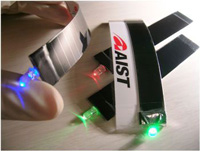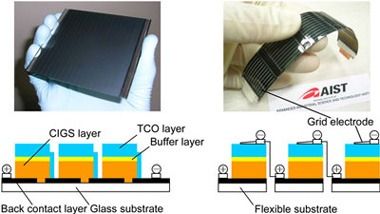
| Home | About Us | Contribute | Bookstore | Advertising | Subscribe for Free NOW! |
| News Archive | Features | Events | Recruitment | Directory |
News
6 April 2010
AIST achieves record efficiency of 15.9% for flexible CIGS solar cell submodule
The Research Center for Photovoltaics at Japan’s National Institute of Advanced Industrial Science and Technology (AIST) has demonstrated record solar energy conversion efficiency for monolithically integrated flexible solar cell submodules of 15.9% (independently certified, for an aperture area of 75.7cm2) using copper indium gallium diselenide (CIGS) thin-film material.
Lightweight and flexible solar cells are attracting attention as a key technology for the wider use of photovoltaic power generation, says AIST, with wider application expected because they can be installed where existing solar cell panel modules cannot be installed. However, it has been difficult to obtain efficiency greater than 10% in a flexible PV module in an integrated structure. AIST has hence worked on the technical challenges of alkali addition control and integration processes, and succeeded in significantly enhancing the efficiency of an integrated-type flexible CIGS solar cell using a practical submodule-size substrate.
 The results of the study were published in the 57th Spring Meeting, 2010 of The Japan Society of Applied Physics at Tokai University (17–20 March) and will be presented at the 35th IEEE Photovoltaic Specialists Conference in Hawaii, USA (20–25 June).
The results of the study were published in the 57th Spring Meeting, 2010 of The Japan Society of Applied Physics at Tokai University (17–20 March) and will be presented at the 35th IEEE Photovoltaic Specialists Conference in Hawaii, USA (20–25 June).
Figure 1: Integrated-type flexible CIGS PV modules and lighting LEDs powered by them.
AIST is promoting the development of technologies for high-performance and highly functional solar cells of various types and for their evaluation. The Research Center for Photovoltaics’ Thin Film Compound Semiconductor Team is hence pursuing R&D of CIGS PV cells in collaboration with universities and companies.
A commercial panel-type CIGS PV module has an integrated structure where several solar cells are connected in series on a glass substrate (Fig. 2, left). On the other hand, in flexible CIGS solar cell modules a solar cell (unit cell) is prepared on each metal foil substrate, and several cells are connected using metal electrodes to form a grid electrode structure (Fig. 2, right). It is difficult to form an integrated structure on a flexible substrate, and high efficiency cannot be realized because of problems posed by requirements such as high-precision alkali addition control. Flexible solar cells fabricated using crystalline materials such as gallium arsenide and silicon also have grid electrode structures.

Figure 2: External appearance and schematic cross-sectional structures of integrated-type (left) and grid-electrode-type (right) modules.
By using an integrated structure, no grid electrode nor bus bar on the solar cell surface is necessary, and a high voltage can be provided even by a single solar cell module sheet. If a high-efficiency integrated-type flexible solar cell is realized, broader applications are enabled via advantages such as the flexibility in designing final products and the convenience of construction. Thus, AIST says that it has met the challenge of realizing an unprecedentedly high-performance integrated-type flexible CIGS solar cell module by applying and extending the technologies that it has developed.
The result was achieved in the ‘Research and development of high-performance technologies on CIGS solar cells (FY2006–FY2009)’ within the contract project, R&D of future technologies on solar power generation systems, of the New Energy and Industrial Technology Development Organization (NEDO).
Previously, AIST developed integration process technologies such as laser scribing and mechanical scribing (to cut, for example, a CIGS layer into strings with a width of several millimeters and spaces of several tens of microns between the strings), and it realized record-performance integrated-type submodules using glass substrates. The technology has been further enhanced and specialized for flexible substrates, leading to AIST integrating CIGS solar cells using a flexible ceramic substrate.
In a CIGS solar cell, by adding an alkali metal such as Na (sodium), the performance-improving ‘alkali effect’ can boost efficiency. However, using a substrate other than soda-lime glass for a panel-type module, efficiency enhancement requires a technology for high-precision alkali control. AIST has therefore established a technology for controlling the alkali content in a CIGS layer by forming a thin layer of alkali-silicate glass as a stable alkali source and by controlling the formation conditions. This technique was applied to a submodule-size flexible substrate to develop the CIGS solar cell.
In particular, an ultra-thin (0.1µm) alkali-silicate glass layer was formed on a flexible ceramic substrate, and a back contact electrode layer of molybdenum was formed on the layer. Then a 2µm-thick CIGS power-generating layer was formed using the evaporation method.
Figure 3 shows the external appearance of the integrated-type flexible CIGS submodule and a rectangular CIGS PV module with a length of 10cm and a width of 2cm, fabricated from the submodule by cutting. The submodule is illuminated by fluorescent light to generate electricity, which then powers some LEDs.

Figure 3: (left) External appearance of an integrated-type submodule fabricated using a 100µm-thick 10cm x 10cm ceramic substrate. (right) Flexible PV module, fabricated by cutting from the submodule using a 300µm-thick substrate, powering an LED to emit light.
In the case of a grid-electrode-type module, the voltage provided by a sheet of CIGS solar cells is less than 1V (equivalent to that of a single solar cell). In contrast, voltages higher than 10V can be obtained in proportion to the number of serially connected solar cells in an integrated-type module. The integrated-type PV module can therefore drive devices that require a high operating voltage. Further, the integrated-type PV module functions even if the light-receiving surface is partially shadowed.
The basic technologies developed to enhance the efficiency of the integrated-type flexible PV submodule can be applied to various types of substrate materials, says AIST. It is therefore now targeting its R&D at applicability to larger-area substrates as well as realizing lower-cost and higher-performance integrated-type flexible PV modules, as well as industrialization through collaboration with commercial companies.
![]() Search: CIGS
Search: CIGS
Visit: www.aist.go.jp
